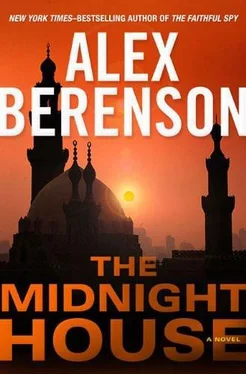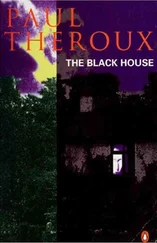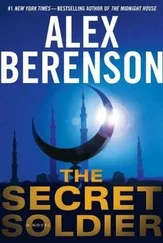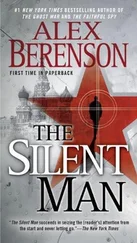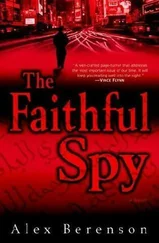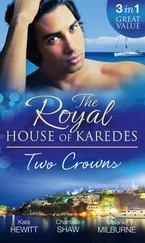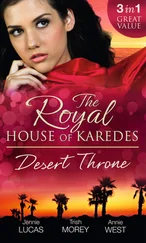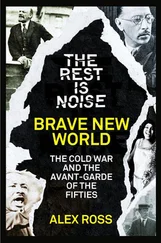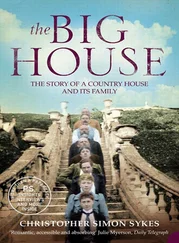Alex Berenson - The Midnight House
Здесь есть возможность читать онлайн «Alex Berenson - The Midnight House» весь текст электронной книги совершенно бесплатно (целиком полную версию без сокращений). В некоторых случаях можно слушать аудио, скачать через торрент в формате fb2 и присутствует краткое содержание. Жанр: Шпионский детектив, на английском языке. Описание произведения, (предисловие) а так же отзывы посетителей доступны на портале библиотеки ЛибКат.
- Название:The Midnight House
- Автор:
- Жанр:
- Год:неизвестен
- ISBN:нет данных
- Рейтинг книги:3 / 5. Голосов: 1
-
Избранное:Добавить в избранное
- Отзывы:
-
Ваша оценка:
- 60
- 1
- 2
- 3
- 4
- 5
The Midnight House: краткое содержание, описание и аннотация
Предлагаем к чтению аннотацию, описание, краткое содержание или предисловие (зависит от того, что написал сам автор книги «The Midnight House»). Если вы не нашли необходимую информацию о книге — напишите в комментариях, мы постараемся отыскать её.
The Midnight House — читать онлайн бесплатно полную книгу (весь текст) целиком
Ниже представлен текст книги, разбитый по страницам. Система сохранения места последней прочитанной страницы, позволяет с удобством читать онлайн бесплатно книгу «The Midnight House», без необходимости каждый раз заново искать на чём Вы остановились. Поставьте закладку, и сможете в любой момент перейти на страницу, на которой закончили чтение.
Интервал:
Закладка:
During the early twentieth century, Cairo had been one of the world’s most cosmopolitan cities, a place where Muslims, Christians, and even Jews lived together peacefully. During World War II, brothels had operated openly just east of downtown, in a district Cairenes had jokingly called “the Blessing.” Egypt’s version of Islam was generally more moderate than that practiced to the east in Saudi Arabia. After all, Egypt’s history long predated Islam. Its proudest moments had come not as a Muslim state but under the pharaohs. And almost ten percent of Egyptians were Christian.
In theory, Egypt still remained moderate today. The nation was the only big Arab power to have made peace with Israel. Women here were allowed to drive and didn’t have to wear head scarves, much less burqas. Cairo was home to an English-language radio station whose announcers openly offered relationship advice. Alcohol was legal, and the city’s big hotels even had casinos, though they weren’t supposed to be open to Egyptians.
But in reality, Egypt had swung toward Islam since throwing off Britain’s colonial yoke in 1952. High birth rates, government bureaucracy, and slow economic growth had left tens of millions of Egyptians living in destitution in the vast slums in and around Cairo. Millions more aspired to the middle class but could not find decent-paying jobs despite college degrees. Many saw Islam as the answer to their country’s crisis. Islamic charities fed and clothed poor families. Islamic courts offered quick decisions to people who couldn’t afford to wait years to be heard by the overcrowded government court system.
But as they promoted charity and community values, Islamic leaders also stoked a fierce anger among their followers: at Egypt’s government, at Israel, and at the United States, which supported both. The United States, so concerned about bringing democracy to Iraq but happy to look the other way when Hosni Mubarak, Egypt’s president, rigged elections to stay in power. Egyptians called Mubarak “the pharaoh,” not only because he had been president for almost thirty years but because he was trying to anoint his son Gamal as his successor.
Year by year, the radicals gained influence. Despite being outlawed, the Muslim Brotherhood, the most important Islamist political party, had won twenty percent of the seats in the Egyptian parliament in the 2005 elections — more than ever before. On the streets, too, the changes were obvious. Even in downtown Cairo, most women wore head scarves, and burqas were not uncommon. Alcohol had largely disappeared outside hotels and a handful of restaurants that catered to tourists. The calls to prayer grew louder each year. And except for the Egyptian Museum, the pyramids, and a few protected neighborhoods, tourists — or non-Arab foreigners of any kind — were almost invisible in Cairo. Despite its grinding poverty, the city was not particularly dangerous for locals. In fact, street crime was rare. But foreign visitors, especially women, faced constant harassment. And with the threat of terrorism vague but real, most tourists stayed off the streets.
Too bad, because Cairo was fascinating, Wells thought. After breakfast he’d walked around downtown, orienting himself, talking to shopkeepers to scrape the last of the rust off his Arabic. Now he was heading east along Sharia al-Azhar, a narrow road that ran under the concrete pylons of an elevated highway. The streets around him formed an area called Islamic Cairo. Almost all of Cairo was Islamic, of course, but this district was the historic center of Islam in Egypt, filled with mosques and madrassas. At its center was al-Azhar University, the second-oldest degree-granting school in the world, established in 975 A.D., hundreds of years before Oxford and Cambridge.
Around Wells, boys carried trays of tea and coffee to men who stood outside their shops. In Cairo, as in many Third World cities, the stores clustered by type. This stretch of road had nothing but textile stores, as though humans needed only brightly colored cloth to survive. The din was constant. Three-wheeled tuk-tuks and skinny 125cc motorbikes buzzed by, and shopkeepers incessantly shouted the praises of their wares.
“Best quality, best quality!”
“Extra-special!”
“Sir, sir! Take a look!”
And step-by-step Wells edged closer to his destination, a mosque a few blocks south, in the very heart of Islamic Cairo.
AN HOUR LATER, just in time for midday Friday prayers, he arrived. The mosque wasn’t big or famous or even particularly old. It had yellow-painted concrete walls and a low minaret mounted with speakers to broadcast calls to prayer. It was the home mosque of Alaa Zumari, the would-be cell-phone mogul scooped up in Iraq and sent to Poland for interrogation by 673.
Wells could have gone straight to the house of Zumari’s family, of course. His dossier had the address. But Zumari was missing. And his mother and father wouldn’t exactly be eager to help a CIA agent find him.
The call to prayer blared. Wells shucked his sandals by the front door and joined the stream of men stepping inside. Islamic law barred artists from painting images of Allah, Muhammad, or even ordinary men and women. Such portraits were considered distracting and disrespectful to God’s majesty. So the mosque had almost no decoration, though its mihrab — the nook that faced toward Mecca — was laid in an ornate pattern of black-and-white tile. With high ceilings and fans spinning overhead, the mosque was notably cooler than the streets. Unseen pigeons cooed from windows high on its back wall.
The mosque’s central hall was nearly one hundred feet square, much bigger than it seemed from outside. Hundreds of men had already arranged themselves in front of the minbar , the wooden pulpit where the imam gave his weekly sermon. Muslims prayed five times a day, every day. But the Friday midday prayer was the week’s most important service, the time when the community gathered. Most men sat near the pulpit, but some stayed back, the cool kids in class, leaning against the walls and chatting with friends as they waited for the service to begin.
Men streamed in, filling the hall. Wells estimated at least a thousand had already arrived. And this was just one mid-sized mosque. Some, like the Mosque of Ibn Tulun south of here, were open squares as big as a city block, capable of holding tens of thousands of men.
The room was notably warmer now, and the odor of a thousand sweating bodies filled the air. Men were supposed to bathe before the midday prayer, but many came straight from work. The men were mostly Arab, though a handful were black, probably Nubian Egyptians or Sudanese from the Upper Nile. Many had faint bruises on their foreheads, a sign of piety. The bruising came from touching their foreheads to the ground as they prayed.
Suddenly the imam mounted the wooden pulpit and began the Surah Fatiha, the first verse of the Quran: “Bismallahi rahmani rahmi al-hamdulillah. ” In the name of Allah, the most gracious, the most merciful; All praises to Allah.
The imam spoke beautifully, Wells thought. Even without amplification, his voice filled the mosque. He finished the surah and began his sermon. “Brothers. Allah tells us that we are not to call ourselves pure. Only he knows who is truly righteous. ” Good deeds would not please God if they were done for selfish reasons, he explained. “Actions are judged by motives.”
As he listened, Wells remembered what he loved most about Islam, the strength and simplicity of its doctrines. The religion had five basic tenets: accept God and Muhammad as His prophet; pray five times a day; give to charity; fast during the month of Ramadan; and travel to Mecca for the sacred pilgrimage of the hajj. Anyone who followed those rules, or sincerely tried to, was a good Muslim.
Читать дальшеИнтервал:
Закладка:
Похожие книги на «The Midnight House»
Представляем Вашему вниманию похожие книги на «The Midnight House» списком для выбора. Мы отобрали схожую по названию и смыслу литературу в надежде предоставить читателям больше вариантов отыскать новые, интересные, ещё непрочитанные произведения.
Обсуждение, отзывы о книге «The Midnight House» и просто собственные мнения читателей. Оставьте ваши комментарии, напишите, что Вы думаете о произведении, его смысле или главных героях. Укажите что конкретно понравилось, а что нет, и почему Вы так считаете.
